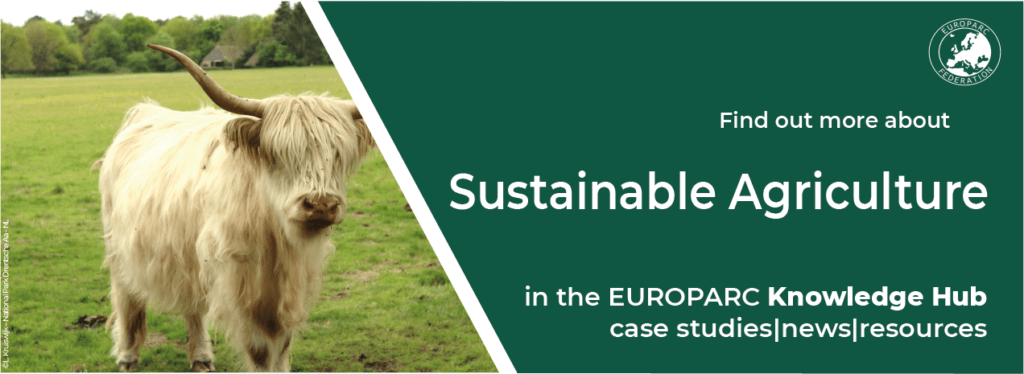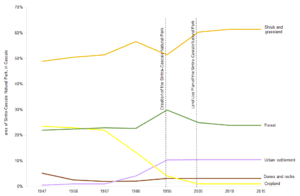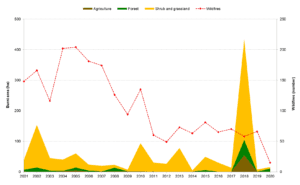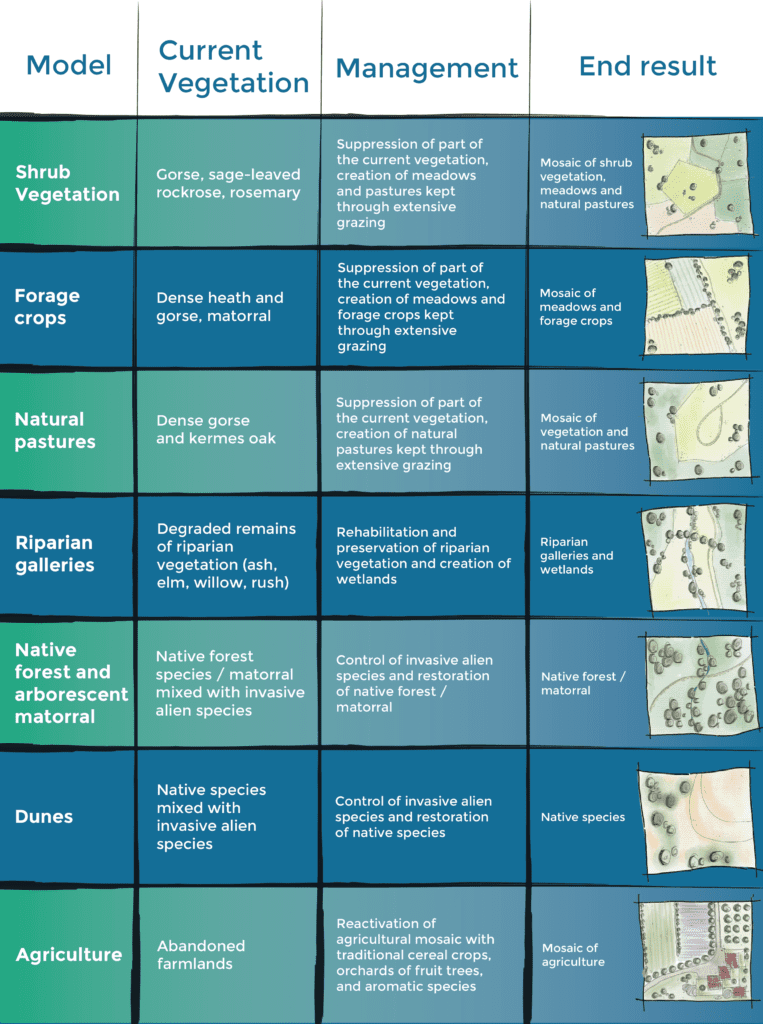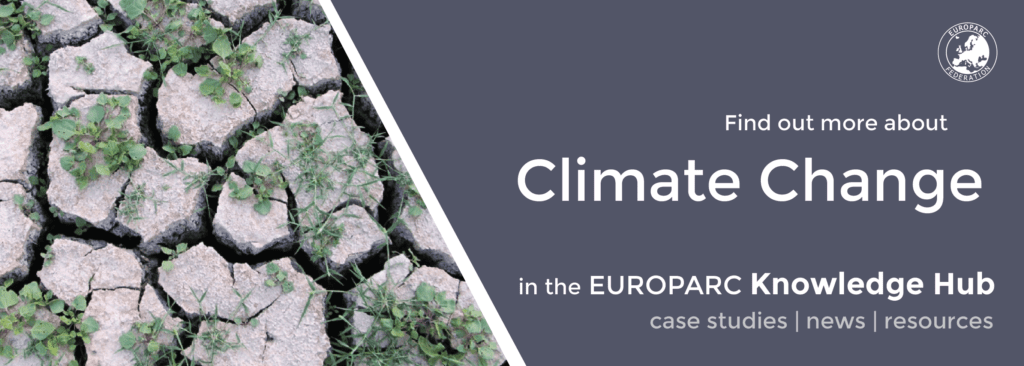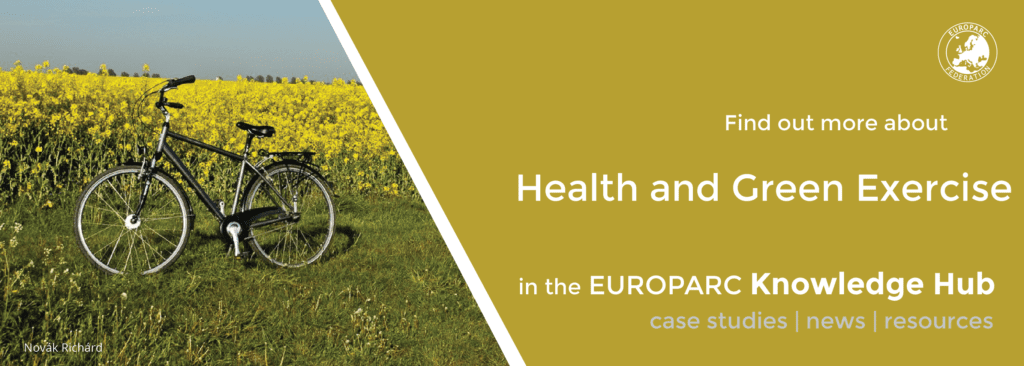Cooperating for Biodiversity: the case of Schiermonnikoog in the Netherlands
In the Netherlands, farmers are protesting the government’s plans to cut nitrogen emissions. This article details the innovative plan created by farmers at Schiermonnikoog that will cut emissions, whilst ensuring the farmers’ livelihoods.
The Nitrogen problem
Agriculture is essential to support human life, but it can also be destructive to nature when practised too intensely. Cattle produced manure, as well as fertilizers, emit high levels of greenhouse gases, amongst which nitrogen. This calls for legislation, policies, and most of all, collaboration, amongst the parties involved to work together toward a more sustainable way of farming. EUROPARC believes that only in working together with farmers, we can reach long-term, sustainable solutions that are Good for People and Good for Nature.
The Netherlands, like other EU countries, is required to protect nature. This pertains especially to the protection of the 162 Natura 2000 areas in the country. For years, the expulsion of nitrogen in The Netherlands has been too high, resulting in damaged and vulnerable nature.
40% of the nitrogen affecting Natura 2000 areas comes from the agricultural sector. This is because of the high amount of cattle in relation to the amount of square meters. The steps undertaken to actively battle the problem have only had limited effects so far. In order to reach the climate goals by 2030, the government plans aim to reduce greenhouse gas nitrogen by 70 percent, mainly in farming areas close to nature reserves. Now, it is clear that in order to drastically reduce the nitrogen output, the amount of cattle in the Netherlands will need to be reduced as well. This poses the question:
Is there a way for farmers and the government to work together towards what is, in the end, a shared goal?
The Schiermonnikoog Island case study detailed here is doing just that.
Cooperating for Biodiversity: the case of Schiermonnikoog in the Netherlands
In the Dutch Waddensea, on the Island of Schiermonnikoog, there are seven dairy farmers. Almost the entire island is designated as a National Park.
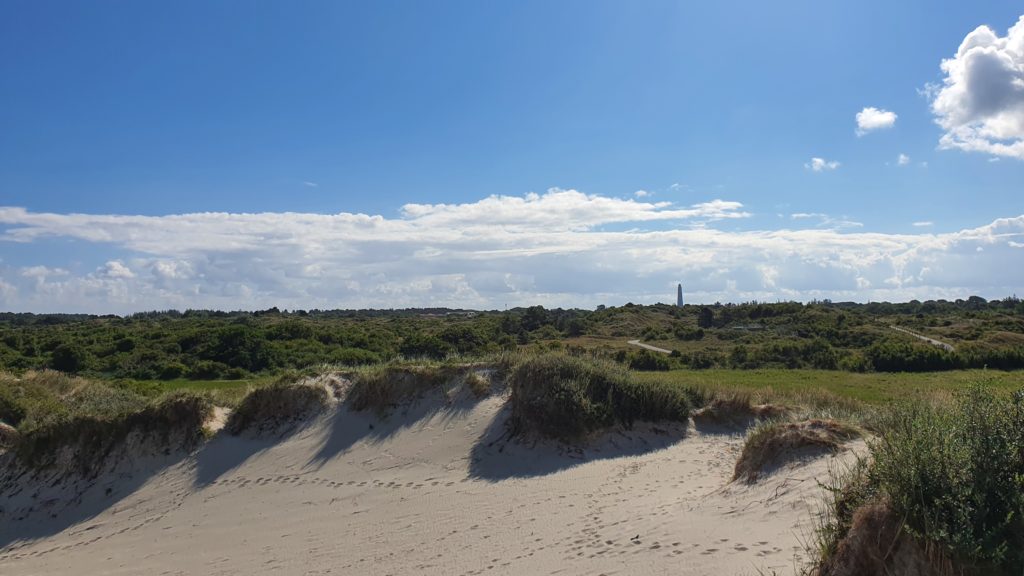
Dune Area at Schiermonnikoog Island © Esther Bossink, EUROPARC
According to the Natura 2000 Schiermonnikoog Management Plan, the nitrogen emissions from agriculture on the vulnerable dunes of Schiermonnikoog are too high. The Dutch government has taken measures by issuing a nitrogen legislation that will mean drastic changes for the agricultural sector. Initially, the province planned to buy farmers out.
As former EUROPARC Intern Lisanne Kruiswijk mentions in her report “From production and protection paradigms to a landscape approach”, the farmers opposed to this idea. Instead, they came up with a collaborative plan. A solution through which the seven dairy farmers of the island would implement nature-promoting measures, including a voluntary decline in the number of cows by no less than 35%.
The pillars of the project
The main goal of the project is the realization of biodiverse agriculture on the island. Together with Natuurmonumenten and other parties, the dairy farmers have drawn up a joint target for 2030. The three pillars on which the project stands are:
1. The realization of biodiverse agriculture on the island: Measures will be implemented to make agriculture on the island more biodiverse, such as strip cultivation, healthier soil life and a substantial reduction in livestock.
2. Producing and selling own dairy products from the Island: The loss of income due to the downsizing of the livestock of cows will be compensated by the creation of a cheese factory on the island, and selling island cheese products.
3. Residual flows: The farmers take care of the residual flows that agricultural production entails. For example, farmers are investigating how best to deal with matters such as:
- Grass clippings from the salt marsh
- Verge clippings
- Cleaning the locks
- Whey from future cheese production
- Solid manure
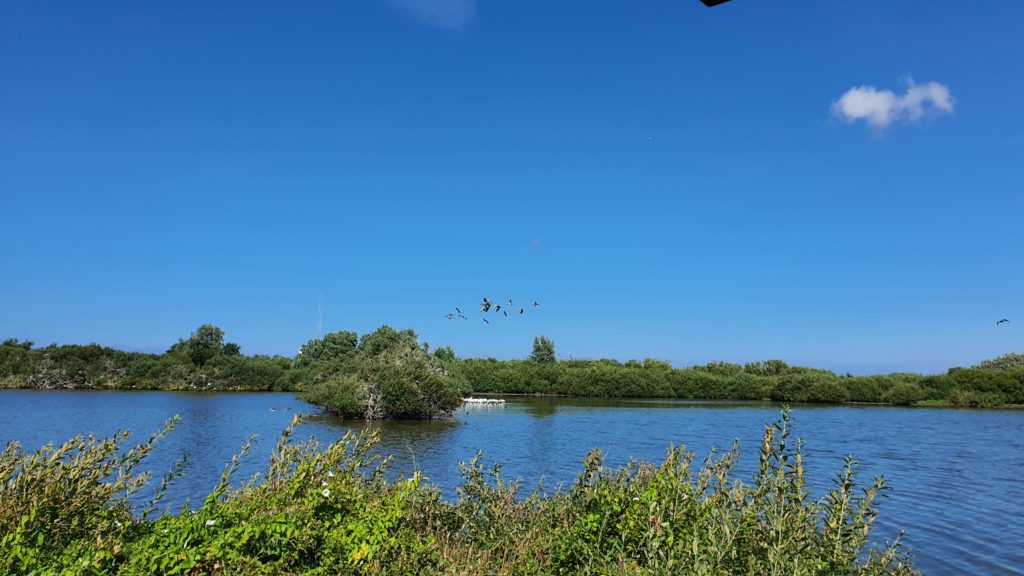
Westerplas at Schiermonnikoog, an important resting place for birds © Esther Bossink, EUROPARC.
The project is financially supported partially by the state, and a big push comes also from the European CAP pilot, in the framework of the agricultural European Innovation Partnership (EIP-AGRI).
Takeaways
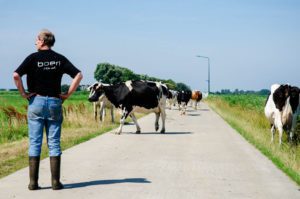
Farmer with cows in Schiermonnikoog
On Schiermonnikoog the farmers are working closely with the government and the business community, such as the Louis Bolk Institute, Ministry of Agriculture, Nature and Food Safety, Provincie Fryslân, Gemeente Schiermonnikoog, D&U Advies, Rabobank, Natuurmonumenten and FrieslandCampina.
Cooperation and collaboration are key to protecting both farmers’ and nature’s interests, and in this case, the location and setup of the island, where stakeholders are highly dependent on one another, played a significant role.
The way forward
This is a great example of a collaborative approach that could be implemented elsewhere. Whilst, there are still roadblocks to tackle, the work on Schiermonnikoog can be seen as “flagship” project on collaboration between farmers, nature managers, private companies and governmental institutions. It reminds us once again that
Alone you go faster, together you go further
Read the full case study here.
EUROPARC’s family keeps growing…check out our new members!
Get to know these 4 new members from Bulgaria, Croatia, Spain, and Switzerland who recently joined the EUROPARC network. Welcome!
BULGARIA
National Protected Areas Control Agency
This new organization was created to assist government institutions and NGO’s in providing active control and monitoring of Bulgaria’s Protected Areas, biodiversity, and ensuring the sustainable use of natural resources. The agency trains mountain rangers and mountain patrols and runs a big training facility in the Balkan Mountains near Sofia, Bulgaria.
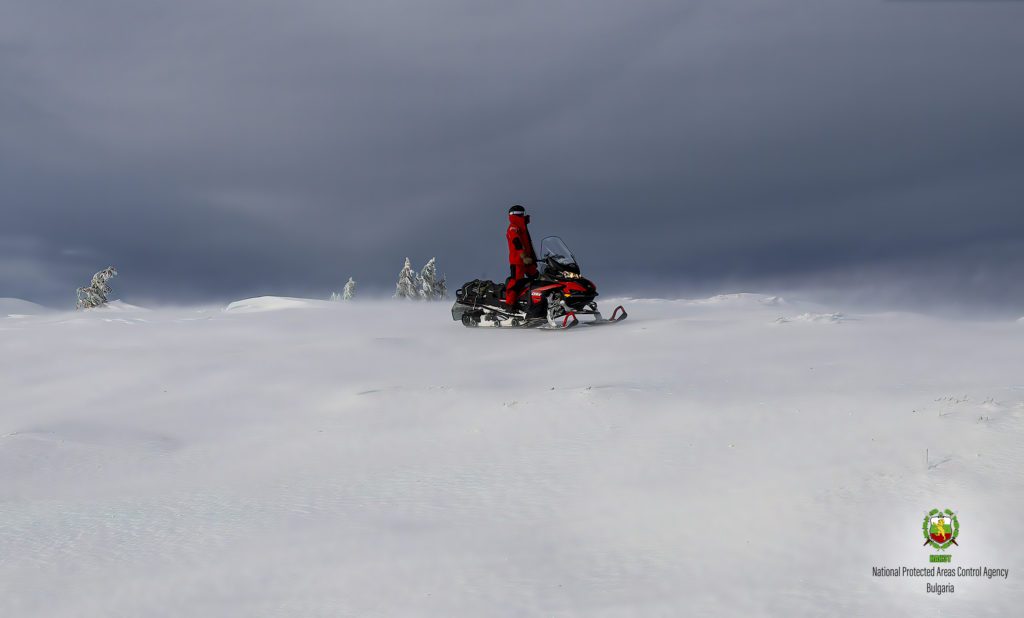
@Nikolai Zlatkov. Mountain ranger on winter patrol, on the main Balkan ridge, 2200 meters altitude, “Zapadna Starat Planina” Protected Area, Bulgaria.
CROATIA
Public Institution Nature of Šibenik – Knin County
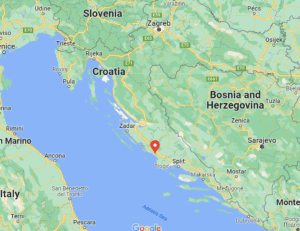
Institution location
The Public Institution Nature of the Šibenik-Knin County was established in 2007.
The primary objective of the organisation is to protect, maintain and preserve the authenticity of the natural environment and to ensure the sustainable use of natural and cultural goods in six designated sites, one nature monument and nearly sixty Natura 2000 areas. In its management area, there is also St Nicholas’ Fortress, a cultural and historical monument under UNESCO protection.
These areas burst with diversified and unique flora and fauna as well as exceptional geomorphological heritage.
SPAIN
Starlight Stellar Park Camino Barranco de Badajoz

Park location
The Parque Estelar Starlight Camino Barranco de Badajoz is located within the Reserva Natural del Cielo y la Tierra (Heaven and Earth Nature Reserve) in the Güímar valley, Tenerife, Spain. Certified by the Starlight Foundation, it is the first astronomical park in the Canary Islands, where activities are organised to observe the night sky, lunar craters, sunspots, and astronomical events.
The Park also organises excursions to the Barranco de Badajoz and the Caserío de San Juan, with the aim to preserve the natural and cultural heritage, by raising awareness about nature, tradition, culture, and customs of our ancestors.
Our mission is to Protect, Conserve and Preserve Nature, to ensure a legacy for present and future generations and to guarantee that all of the resources we have received are returned to Nature.
SWITZERLAND
Greifensee-Foundation
As an NGO, the Greifensee Foundation is committed to the preservation and further development of the Greifensee landscape and manages the associated nature reserve on behalf of the Canton of Zurich. The rangers control and supervise compliance with the protection ordinances at Lake Greifensee and inform visitors about the Protected Area. The Greifensee Foundation also runs the Silberweide Nature Station and the Junior Ranger and Young Ranger Programme.

Der See im Sommer, Greifensee-Stiftung, Switzerland
The Greifensee is the largest Protected Area in the canton of Zurich and has been a national water and migratory bird reserve since 2009. Thanks to the undeveloped banks, reed belts, fens and reed meadows have been preserved.
Would you like to be part of the biggest network of Protected Areas in Europe?
Read all about it on this page.
Managing the landscape to control wildfires
Wildfires are not new occurrences, however climate change will cause them to be more and more frequent, even in areas previously not at high risk. So, how can we manage the landscape to limit the negative impacts of these fires? This expert article, written by EUROPARC Council Member João Cardoso de Melo, Marlene Marques and Débora Hemriques, details the experience of Sintra-Cascais Natural Park in Portugal.
Climate Change & Wildfires in Europe
Over the last decade there have been recurrent wildfires in Europe, with the 2021 wildfire season being the second-worst on record, according to the Advance EFFIS Report on Forest Fires in Europe, Middle East and North Africa (2021). The IPCC climate change projections (2022) predict an increase in temperature and more extended dry periods, expecting an increase in the frequency of droughts, heatwaves and other extreme weather events. Wildfires have been particularly harmful in Southern Europe (France, Greece, Italy, Portugal and Spain). Portugal has one of the highest forest fire risk rankings in Europe.
On October 6th, 2018, a wildfire burned 429.0 ha of the Sintra-Cascais Natural Park (SCNP) (about 3.0% of its total area) and had significant environmental, societal and landscape impacts, endangering people, and villages, affecting forestland and other natural areas. This event was a severe warning that wildfires, which occur annually in rural areas, can also happen in peri-urban areas, and threaten densely populated urban villages. Given this scenario, the combination of unmanaged areas and climate change pressures can promote even more severe, frequent, and large-scale wildfires in the future.
About Sintra-Cascais Natural Park
The SCNP, with a total area of 14,446.31 ha, is located within the municipalities of Sintra (11,174.75 ha) and Cascais (3,271.56 ha), two of the most densely populated counties in Portugal. It is classified as a
protected area by the Portuguese governmental Institute for Nature Conservation and Forests and a part of the Natura 2000 network for conservation of habitats and species under the Habitats Directive. It also includes the area classified by UNESCO as Sintra World Heritage Cultural Landscape, both by its cultural interest and natural beauty. The SCNP, characterized by diversified natural and semi-natural landscapes and a high environmental, historic, cultural and social heritage, is very popular for outdoor nature activities such as hiking, trekking, mountain biking and trail running.
Cascais Ambiente it’s a municipal company who provides technical support and manages the Cascais municipality southern SCNP area (SCNP-C). The company was tasked to implement a landscape management and conservation plan to restore the burnt area and implement actions to mitigate the risk of wildfires and adapt the landscape to climate change.
What needs to change?
We have studied the wildfires of the last 30 years, to analyse its recurrence and patterns in the landscape, the relation with human presence and land use, the type of wildfire progression, and the vegetation, meteorology, and topographic characteristics. The SCNP-C landscape has been shaped by agroforestry abandonment and a consequent increase of wildfire episodes. The annual burnt area averages around 80 ha and large wildfire, more than 400 ha, have an average recurrence of six years. The wildfires with the greatest burnt extension correspond mostly to fires dominated by the wind, some of them coinciding with the main wind corridors.
As the wildfires drivers are the meteorology, topography and vegetation, only the last one can be managed. Thus,
our goal is to introduce changes in the landscape and land use, not to avoid wildfires, but to contain their uncontrolled progression.
How can we use landscape management for wildfire prevention?
In SCNP-C, vegetation management has been implemented around main villages and roads. However, they are useless where wildfires are topographic. Thus, a new approach is needed to allow better suppression opportunities, but also promotes a sustainable management and the development of new dynamics to promote the economic and social development based on nature tourism and local farming.
To pursue this vision, the project is structured on three main pillars of action:
- Tackle and build landscape resilience to climate change impacts, particularly to wildfires, while preventing soil erosion, promoting the diversification of ecosystem services and ensuring biodiversity and ecological corridors by implementing sustainable agro-silvo-pastoral management models;
- Develop and demonstrate the sustainability and profitability of local economies based on agro-silvo-pastoral activities and ecotourism by fostering local production and promoting green jobs;
- Improve the knowledge base, develop awareness, and promote the engagement of stakeholders and the local community in climate change adaptation actions.
Concept and Methodology
The expected increase in global temperature will raise the frequency of drier periods leading to even more severe and large-scale wildfires, placing people, villages and biodiversity at risk. If the problem is not addressed, a scenario of severe and extensive wildfires could become even more frequent and endanger the sustainability and the communities of the SCNP-C.
Considering the particular characteristics of the SCNP-C area a set of management models were outlined according to local characteristics, mainly current vegetation and land use, biophysical attributes such as relief, climate variables (temperature, wind), soil type, hydrogeology, and historical wildfires (recurrence impacts). The implementation of these models will create a mosaic of different land-uses, generate vegetation discontinuities and undo the continuum that promotes extensive and severe wildfires, facilitate its suppression. It will also promote biodiversity and diversification of ecosystem services. These models will ensure natural and stable vegetation management, reducing human intervention and associated costs.
Find the exact management measures in the table here:
EUROPARC thanks João Cardoso de Melo, Marlene Marques and Débora Hemriques for writing this article. João was also part of the 2022 edition of EUROPARC’s Siggen Seminar, which focussed on the role of Protected Areas in Nature Restoration. You can find the outcomes here.
UN make a decisive move on Right to a Healthy Environment
Scarpe escaut Nature Regional Park, France © Samuel Dhote
On 28 July, the UN General Assembly (UNGA) recognized a clean, healthy and sustainable environment as a universal human right.
What is the declaration?
This UNGA declaration states that everyone has a right to a healthy environment. This includes clean air and water, as well as a stable climate.
As the UNGA is the UN’s only forum with representation of all its 193 Member States, this resolution is historic.
Inger Andersen, the Executive Director of the UN Environment Programme (UNEP) declared:
The resolution will trigger environmental action and provide necessary safeguards to people all over the world. It will help people stand up for their right to breathe clean air, to access safe and sufficient water, healthy food, healthy ecosystems, and non-toxic environments to live, work, study, and play.
What does it mean?
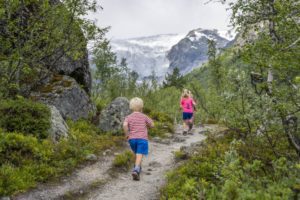
Bergsetbreen Glacier, Norway. Photo Vegard Aasen
Though not legally binding, this resolution paves the way for an acceleration toward the goal of an inclusive, green recovery. How? For instance, by incorporating the right to a healthy environment into national constitutions. People could then use national human rights law against environmentally destructive policies.
EUROPARC welcomes this normative development and reaffirms its commitment to human rights. As the representative voice of Protected Areas in Europe, we have long advocated for a healthy nature, to support a healthy society.
What is EUROPARC doing?
On the advocacy side, EUROPARC became the chair of the Environment, Climate Change, Heritage and Health Committee (ECCH&H) at the Conference of INGOs at the Council of Europe last year. The objective of this Committee is that:
human rights of European citizens are upheld with respect to the impacts of climate change, biodiversity loss and the connection between people and natural and cultural heritage.
The UN resolution further legitimises this important work.
EUROPARC invests energy and resources on several initiatives for Protected Areas, focusing on topics such as climate change adaptation, youth or health & nature, just to name a few.
Michael Hošek EUROPARC Federation President stated:
This welcome declaration will be an impetus to ensure people have access to a clean and safe environment, not only close to where they live, but in the nature that surrounds them. Protected Areas already give millions of Europeans access to a “clean, healthy and sustainable environment” and we need to ensure our parks are valued and invested in, to secure these nature and health benefits.
What can your Protected Area do?
Healthy Parks make Healthy People and are well suited to lead us into a green future – EUROPARC is there to support in this pathway.
The right access to a “clean, healthy and sustainable environment” is important to us all, so:
- If you want to know more
- If you want to contribute
Then, have a look at our resources on Climate Change Adaptation, join the different EUROPARC initiatives, like Healthy Parks Healthy People Europe or the programmes for Young People in Protected Areas.
Share your knowledge through any of our initiatives!
Together, we can create the green and healthy future of tomorrow.
